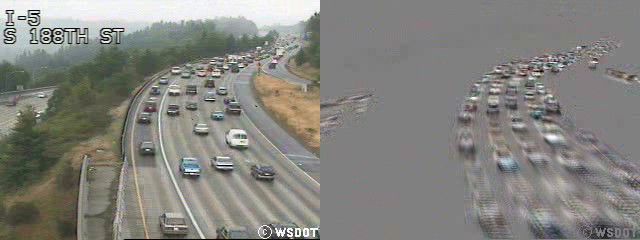
| Home | People | Research | Publications | Demos |
| News | Jobs |
Prospective
Students |
About | Internal |

| Classification and Retrieval of Traffic Video | |

|
|
|
In recent years, the use of video systems for traffic monitoring has shown promise over that of traditional loop detectors. The analysis of traffic video can provide global information, such as overall traffic speed, lane occupancy, and individual lane speed, along with the capability to track individual cars. Because video systems are less disruptive and less costly to install than loop detectors, interest has grown in building and using large camera networks to monitor different aspects of traffic, such as traffic congestion. Most of the existing work in monitoring traffic uses a vehicle segmentation and tracking framework. First, a potential vehicle is segmented from the scene using motion cues. Once segmentation is performed, the objects are tracked between frames using various methods, such as rule-based systems or Kalman filters. The vehicle tracking framework has the disadvantage that its accuracy is dependent on the quality of the segmentation. The segmentation task becomes more difficult with the presence of adverse environmental conditions, such as lighting (e.g. overcast, glare, night), shadows, occlusion, and blurring. Furthermore, segmentation cannot be performed reliably on low resolution images where the vehicles only span a few pixels. Tracking algorithms also have problems when there are many objects in the scene, which is typically the case for highways scenes with congestion. In this project, we model the motion field as a whole using a generative probabilistic model, the dynamic texture. The motion from the video sequence is abstracted and represented as a generative model, thus avoiding the difficulties of segmentation and tracking. Furthermore, using a probabilistic model allows for a rich variety of distance functions and classifiers that are based on probability and information theory. In particular, classification can be performed using the probabilistic SVM framework, which combines the generalization guarantees of the large-margin SVM method, with the robustness of the underlying probabilistic models. For retrieval, the probabilistic model allows for advanced systems such as Bayesian retrieval. Experimental results show that this framework is useful in tasks such as traffic video retrieval and classification of congestion in traffic sequences, and that the model is robust to lighting conditions, occlusion, and blurring. |
|
| Selected Publications: |
|
| Demos/ Results: |
|
| Database: |
|
| Contact: | Antoni Chan, Nuno Vasconcelos |
![]()
©
SVCL